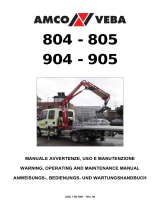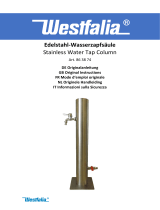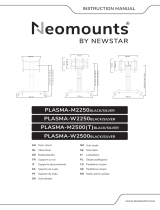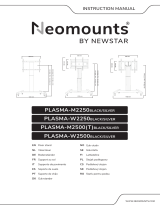Facom DL.20EU Owner's manual
- Category
- Toys & accessories
- Type
- Owner's manual
This manual is also suitable for
Page is loading ...
Page is loading ...
Page is loading ...

EN
GUARANTEE
Type D = 2 years. See the general conditions in the FACOM catalogue or the FACOM price list.
Subject to compliance with all of the above instructions.
ASSEMBLY
As we are handling heavy elements, it is essential to carry out the following assembly processes with the help of other people.
1. To assemble the legs (B1 and B2) of DL.5 cranes, it is necessary to position the crane on the ground with the wheels in the position indicated in Figure (C). Start by extracting the rivet (B3) turning it until its fi xed
limit (B6) which coincides with the window. With the legs on the ground, introduce the rivet (B3) in the outlets (B5 and B5), making the fi xed limit coincide (B6) with the outlet window. Turn the rivet slightly in order
to prevent it from falling out, hence securing the legs to the base of the crane. Perform the reverse operation to fold the legs.
2. DL.10EU cranes are assembled by positioning the column (E) on the legs (F), securing it with the screws provided. Beforehand, wedge the wheels to avoid the movement of the crane. The arm (G) is then assembled
with its slide (H) to the column and fi nally to the hydraulic unit (I) on a support located on the column. The operation is completed with the securing of the central piston to the arm (G) using a rivet and two elastic
rings.
USE AND OPERATION
1. Prior to using the crane, the hydraulic circuit needs to be drained in order to eliminate any air from the valve system of the hydraulic unit. From behind the crane, turn the group (9) handle 90º whilst pumping the
hydraulic unit several times. By releasing the handle (9), the crane is ready for use. Turn the hydraulic unit to activate the pump from the most comfortable work position.
2. To lift the load, activate the lever (10) which enables you to choose a comfortable position due to the fact it is revolving. If lifting an engine, secure it at the points recommended by the manufacturer.
3. If it is necessary to use the crane in other positions, the slide should be perfectly fi tted to the limiting screw (7).
4. To lower the load, turn the handle (9). This system enables the lowering to be regulated and controlled manually and precisely.
The crane will stop the lowering process when the handle is not activated.
5. ollowing use of the crane, the piston of the hydraulic unit should be fully retracted. First move the slide to its initial position (7).
MAINTENANCE
Important:
Both the maintenance and repair of this crane may only be carried out by qualifi ed and authorized personnel, who as a result of their training and experience are familiar with the hydraulic systems used in these
devices.
1. Clean and lubricate the axes of the moving parts of the crane (9) at regular intervals. The crane should be kept clean and protected from aggressive conditions at all times.
2. Only original spare parts should be used.
3. Withdraw the crane from service if it is suspected that it has been subjected to abnormal loads or has suffered any type of knock until the problem has been resolved.
4. If the oil level needs to be checked or refi lled, dismantle the hydraulic unit and with the piston fully retracted, remove the fi ller plug and drain its contents into a container. With the hydraulic in a horizontal position,
proceed to introduce the necessary volume for each model as indicated in these instructions. Avoid the entrance of any dirt with the new oil.
Important: An excess of oil over the volume required may affect the operation of the crane.
5. Only use hydraulic oil, HL or HM type, with an ISO grade of cinematic viscosity of 30cSt at 40ºC or of an Engler viscosity of 3 at 50ºC.
Extremely important: Never use brake fl uid.
6. When the crane is not in use, it should be fully retracted in the lowest position so as to minimize piston corrosion (11). It is recommendable to apply an anti-corrosion product to the main piston and to the pump.
7. Store the crane in a dry, clean place, out of the reach of children.
8. At the end of the useful life of the crane, drain off the oil and hand it over to an authorised agent and dispose of the remaining parts in accordance with local regulations.
9. Both the repair kit, which exclusively contains the retainers and joints and the spare part sets must be ordered using the reference assigned in the table.
USER LIABILITY
Before using the crane, read the following instructions and precautions.
The non-application of these precautions may result in damaging the crane, and may even hurt users.
Inform appropriately the workers in charge of using and maintaining the work equipment, and notably on the conditions of use of work equipment, instructions, or guidelines concerning them.
Check the lifting devices:
- Check when initiating a task, upon fi rst use of the device, whether new or second-hand, in the workshop
- Check upon start-up, to be performed upon dismounting and refi tting, modifi cation, major repair or accident caused by a device failure.
- General periodical checks, performed on a regular basis, aiming at timely detection of any damage likely to create a hazard.
These checks concern devices powered mechanically as well as devices powered by human force. The result of these checks must be recorded in the safety log opened by the site manager.
When devices are faulty, forbid their use or repair immediately.
For manual handling, provide the staff with the individual protections required: safety shoes, preferably in materials resistant to hydrocarbons, protection gloves, etc.
In mechanical handling, unless during tests or proofi ng, never lift a load exceeding that specifi ed on the device.
When using a crane, the following must be ensured:
1. the maximum operating load (1) must be mentioned on the crane,
2. each jack must be checked:
- every year in the case of normal use,
- every 6 months in the case of heavy use,
- immediately after use in special conditions, notably after an accidental overload.
Cranes must be used only to lift or move a load.
WARNINGS !
1. Before lifting a load, ensure it is on a stable, fl at, horizontal and clean surface (no grease nor oil) (2).
2. Check the load to lift is perfectly immobilised (3).
3. To support the load, use another appropriate means, e.g. a FACOM trolley CR.6 (4).
4. To prevent the assembly from slipping, always centre the load on the crane (6) using the FACOM spreader DL.101.
5. Never use extensions (5).
6. Check the oil level regularly (8). Conversely, too much oil can damage or alter the adjustment of the devices (see « instructions before use «).
7. When changing the oil, never use brake fl uid, alcohol, glycerine, detergents, motor oil or used oil. Using dirty oil can cause major internal damage to your equipment. For more information, contact your FACOM
distributor directly. FACOM recommends using the oil reference WA.21.
8. Check the precaution label is legible at all times.When retrofi tting your equipment, these labels are available (A) as well as the operating instructions (
Q.NU-DL.5-20EU/1008
).
INSTRUCTIONS FOR PERFECT USE
1. Before each use, check the crane. You must particularly check for oil leaks, damaged or missing parts.
2. Faulty parts must be replaced by skilled staff with FACOM original parts.
3. Each part in the crane must be checked in case of load considered abnormal or following a shock.
11
NU-DL.5-20EU_1008.indd 4 27/10/2008 11:37:00
Page is loading ...
Page is loading ...
Page is loading ...
Page is loading ...
Page is loading ...
Page is loading ...
Page is loading ...
Page is loading ...
Page is loading ...

FR DECLARATION DE CONFORMITE
NOUS, FACOM S.A.S., 6/8 RUE GUSTAVE EIFFEL - BP 99 - 91 423 MORANGIS CEDEX FRANCE, DECLARONS SOUS NOTRE PROPRE RESPONSABILITE
QUE LES PRODUITS :
DL.5, DL.10EU, DL.20EU – GRUES: 500 kg, 1000 kg, 2000 kg Marque FACOM
SONT CONFORMES AUX DISPOSITIONS DES DIRECTIVES EUROPEENES SUIVANTES :
- DIRECTIVE “ MACHINES ” DI/98/37/CE ANNEXES I, II, III ET V
EN DECLARATION OF COMPLIANCE
WE, FACOM S.A.S., 6/8 RUE GUSTAVE EIFFEL - BP 99 - 91 423 MORANGIS CEDEX FRANCE, STATE UNDER OUR LIABILITY THAT THE FOLLOWING
PRODUCTS:
DL.5, DL.10EU, DL.20EU – CRANES: 500 kg, 1000 kg, 2000 kg by FACOM
COMPLY WITH THE PROVISIONS SET OUT IN THE FOLLOWING EUROPEAN DIRECTIVES:
- “ MACHINES “ DIRECTIVE DI/98/37/CE APPENDICES I, II, III AND V
DE KONFORMITÄTSERKLÄRUNG
WIR, FACOM S.A.S., 6/8 RUE GUSTAVE EIFFEL - BP 99 - 91 423 MORANGIS CEDEX FRANKREICH, BESCHEINIGEN HIERMIT IN ALLEINIGER VERAN-
TWORTUNG, DASS DIE ERZEUGNISSE:
DL.5, DL.10EU, DL.20EU – KRÄNE: 500 kg, 1000 kg, 2000 kg Marke FACOM
MIT DEN BESTIMMUNGEN DER FOLGENDEN EUROPÄISCHEN RICHTLINIEN ÜBEREINSTIMMEN:
- „MASCHINENRICHTLINIE” DI/98/37/EG ANHÄNGE I, II, III UND V
NL CONFORMITEITSVERKLARING
ONDERGETEKENDE, FACOM S.A.S., 6/8 RUE GUSTAVE EIFFEL - BP 99 - 91 423 MORANGIS CEDEX FRANKRIJK, VERKLAART ONDER DE EIGEN
VERANTWOORDELIJKHEID DAT DE PRODUCTEN:
DL.5, DL.10EU, DL.20EU – KRAANE: 500 kg, 1000 kg, 2000 kg Merk FACOM
VOLDOEN AAN DE BEPALINGEN VAN DE VOLGENDE EUROPESE RICHTLIJNEN:
- ‘’ MACHINERICHTLIJN ‘’ DI/98/37/EG AANHANGSEL I, II, III EN V
ES DECLARACIÓN DE CONFORMIDAD
NOSOTROS, FACOM S.A.S., 6/8 RUE GUSTAVE EIFFEL - BP 99 - 91 423 MORANGIS CEDEX FRANCIA, DECLARAMOS BAJO NUESTRA PROPIA
RESPONSABILIDAD QUE LOS PRODUCTOS:
DL.5, DL.10EU, DL.20EU – GRÚAS: 500 kg, 1000 kg, 2000 kg Marca FACOM
SON CONFORMES A LAS DISPOSICIONES DE LAS SIGUIENTES DIRECTIVAS EUROPEAS:
- DIRECTIVA ‘’MÁQUINAS’’ DI/98/37/CE ANEXOS I, II, III Y V
IT DICHIARAZIONE DI CONFORMITÀ
LA SOTTOSCRITTA, FACOM S.A.S., 6/8 RUE GUSTAVE EIFFEL - BP 99 - 91 423 MORANGIS CEDEX FRANCE, DICHIARA SOTTO LA PROPRIA RESPONSABI-
LITA’ CHE I PRODOTTI :
DL.5, DL.10EU, DL.20EU – GRU: 500 kg, 1000 kg, 2000 kg Marca FACOM
SONO CONFORMI ALLE DISPOSIZIONI DELLE SEGUENTI DIRETTIVE EUROPEE :
- DIRETTIVA Ò MACCHINE Ó DI/98/37/CE ALLEGATI I, II, III E V
PO DECLARAÇÃO DE CONFORMIDADE
NÓS, FACOM S.A.S., 6/8 RUE GUSTAVE EIFFEL - BP 99 - 91 423 MORANGIS CEDEX FRANCE, DECLARAMOS A NOSSA PRÓPRIA RESPONSABILIDADE
SOBRE OS PRODUTOS:
DL.5, DL.10EU, DL.20EU – GRUA: 500 kg, 1000 kg, 2000 kg Marca FACOM
ESTÃO EM CONFORMIDADE COM AS DISPOSIÇÕES DAS SEGUINTES DIRECTIVAS EUROPEIAS:
- DIRECTIVA “MÁQUINAS“ DI/98/37/CE ANEXOS I, II, III E V
PL DEKLARACJA ZGODNOŚCI
FIRMA FACOM S.A.S. 6/8 RUE GUSTAVE EIFFEL - BP 99 - 91 423 MORANGIS CEDEX FRANCJA OŚWIADCZA NA
SWOJĄ CAŁKOWITĄ ODPOWIEDZIALNOŚĆ, ŻE PRODUKTY:
DL.5, DL.10EU, DL.20EU –
DŹWIG
: 500 kg, 1000 kg, 2000 kg
Marki FACOM
JEST ZGODNY Z ZALECENIAMI NASTĘPUJĄCYCH DYREKTYW EUROPEJSKICH:
- DYREKTYWA "MASZYNY"
DI/
98/37/CE Z ZAŁĄCZNIKAMI I, II, III i V
DK OVERENSSTEMMELSESERKLÆRING
VI, FACOM S.A.S., 6/8 RUE GUSTAVE EIFFEL - BP 99 - 91 423 MORANGIS CEDEX FRANKRIG, ERKLÆRER UNDER VORES EGET ANSVAR, AT PRODUKTERNE :
DL.5, DL.10EU, DL.20EU – KRAN: 500 kg, 1000 kg, 2000 kg AF Mærket FACOM
OVERHOLDER BESTEMMELSERNE I FØLGENDE EUROPÆISKE DIREKTIVER:
- MASKINDIREKTIV DI/98/37/EØF BILAG I, II, III OG V
GR ΔΗΛΩΣΗ ΣΥΜΜΩΡΦΩΣΗΣ
Η ΕΤΑΙΡΕΙΑ FACOM S.A.S., ΜΕ ΕΔΡΑ 6/8 RUE GUSTAVE EIFFEL - BP 99 - 91 423
MORANGIS CEDEX ΓΑΛΛΙΑ, ΔΗΛΩΝΕΙ ΜΕ ΑΠOΚΛΕΙΣΤΙΚΗ ΤΗΣ ΕΥΘΥΝΗ, OΤΙ ΤΑ ΠΡOΪOΝΤΑ:
DL.5, DL.10EU, DL.20EU –
ΓΕΡΑΝΟΙ
500 kg, 1000 kg, 2000 kg κατασκευής FACOM
ΠΛΗΡOΥΝ ΤΙΣ ΠΡOΔΙΑΓΡΑΦΕΣ ΤΩΝ ΠΑΡΑΚΑΤΩ ΕΥΡΩΠΑΪΚΩΝ OΔΗΓΙΩΝ:
ΟΔΗΓΙΑ "ΠΕΡΙ ΜΗΧΑΝΗΜΑΤΩΝ" DI/98/37/ΕΚ ΠΑΡΑΡΤΗΜΑΤΑ I, II, III και V
Le Responsable Qualité FACOM
The FACOM Quality Manager
Le Responsable Qualité FACOM
The FACOM Quality Manager
NOTE:
NU-DL.5-20EU_1008.indd 14 27/10/2008 11:39:58

N° de série - Serial number - Serien-Nr. - Serienr. - N° de serie
N° di serie - N.° de série - Nr seryjny - Serienr. -
Σειριακός αριθμός :
...................................................................................................................................................
Date de fabrication - Date of manufacture - Herstellungsdatum - Fabricagedatum - Fecha de fabricación
Data di fabbricazione - Data de fabrico - Data produkcji - Fabrikatiosdato -
Ημερομηνία κατασκευής
: ................................................................................................
Modèle - Model - Modell - Model - Modelo - Modello - Modelo - Model - Model -
Μοντέλο
: ..................................................................................................................
Fabricant - Manufacturer - Hersteller - Fabrikant - Fabricante - Fabbricante - Fabricante
Producent - Fabrikat -
Κατασκευαστής
: ............................................................................................................................................................................................
Mise en service - Date placed in service - Inbetriebnahme - Inwerkingstelling - Puesta en servicio Messa in servizio - Colocação em funcionamento
Oddanie do użytkowania
- Ibrugtagningsdato - Επισκευή
Examen d’adéquation Date .............................
Compliance inspection Date .............................
Übereinstimmungsprüfung Datum ..........................
Gelijkvormigheidsonderzoek Datum ..........................
Examen de adecuación Fecha ...........................
Esame di adeguamento Data .............................
Exame de adequação Data .............................
Kontrola zgodności
Data .............................
Egnethedstest Den ..............................
Έλεγχος επάρκειας
Ημερομηνία .....................
Essai de fonctionnement Date .............................
Operating test Date .............................
Funktionsprüfung Datum ..........................
Funcioneringsproef Datum ..........................
Prueba de funcionamiento Fecha ...........................
Test di funzionamento Data .............................
Exame de funcionamento Data .............................
Testy działania
Data .............................
Funktionstest Den ..............................
Έλεγχος λειτουργίας
Ημερομηνία ...................
Cachet / Signature
Seal/Signature
Stempel/Unterschrift
Handtekening
Sello/Firma
Timbro/Firma
Carimbo/Assinatura
Pieczęć/Podpis
Stempel/Underskrift
Σφραγίδα / Υπογραφή
IDENTIFICATION DU MATERIEL
TYPE OF EQUIPMENT
IDENTIFIZIERUNG DES MATERIALS
IDENTIFICATIE VAN HET MATERIAAL
IDENTIFICACIÓN DEL MATERIAL
IDENTIFICAZIONE DEL MATERIALE
IDENTIFICAÇÃO DO MATERIAL
IDENTYFIKACJA WYPOSAŻENIA
IDENTIFIKATION AF MATERIELLET
ΣΤΟΙΧΕΙΑ ΥΛΙΚΟΥ
Cachet / Signature
Seal/Signature
Stempel/Unterschrift
Handtekening
Sello/Firma
Timbro/Firma
Carimbo/Assinatura
Pieczęć/Podpis
Stempel/Underskrift
Σφραγίδα / Υπογραφή
DL.10EUDL.5 DL.20EU
NU-DL.5-20EU_1008.indd 15 27/10/2008 11:39:59
Page is loading ...

u
es, remplacement, modifi cations effectuées sur le matériel.
o
ns, replacements and alterations to the machine
g
elmäßigen Prüfungen, Austauschmaßnahmen und Änderungen.
e
s, vervangingen, wijzigingen uitgevoerd aan het materiaal.
r
iódicas, reemplazo, modifi caciones efectuadas en el material.
odica, sostituzione, modifi che effettuate sul materiale.
s
periódicas, substituição, alterações ao material.
m
iany, wprowadzonych modyfikacji w wyposażeniu.
u
dskiftning og ændringer, der er foretaget på materiellet.
αντικατάστασεις, τροποποιήσεις που έγιναν στο υλικό.
Périodicité
Frequency
Häufi gkeit
Periodiciteit
Periodicidad
Periodicità
Periodicidade
Okresowość
Interval
Περιοδικότητα
Références des pièces changées
Part numbers replaced
Bestellnummern der ausgetauschten Teile
Referenties van de vervangen stukken
Referencias de las piezas cambiadas
Referenza dei pezzi sostituiti
Referências das peças substituídas
Symbole wymienionych części
Varenummer på udskiftede dele
Κωδικοί εξαρτημάτων που αντικαταστήθηκαν
Signature
Signature
Unterschrift
Handtekening
Firma
Firma
Assinatura
Podpis
Underskrift
Υπογραφή
NU-DL.5-20EU_1008.indd 17 27/10/2008 11:40:20
Page is loading ...

u
es, remplacement, modifi cations effectuées sur le matériel.
o
ns, replacements and alterations to the machine
g
elmäßigen Prüfungen, Austauschmaßnahmen und Änderungen.
e
s, vervangingen, wijzigingen uitgevoerd aan het materiaal.
r
iódicas, reemplazo, modifi caciones efectuadas en el material.
odica, sostituzione, modifi che effettuate sul materiale.
s
periódicas, substituição, alterações ao material.
m
iany, wprowadzonych modyfikacji w wyposażeniu.
u
dskiftning og ændringer, der er foretaget på materiellet.
αντικατάστασεις, τροποποιήσεις που έγιναν στο υλικό.
Périodicité
Frequency
Häufi gkeit
Periodiciteit
Periodicidad
Periodicità
Periodicidade
Okresowość
Interval
Περιοδικότητα
Références des pièces changées
Part numbers replaced
Bestellnummern der ausgetauschten Teile
Referenties van de vervangen stukken
Referencias de las piezas cambiadas
Referenza dei pezzi sostituiti
Referências das peças substituídas
Symbole wymienionych części
Varenummer på udskiftede dele
Κωδικοί εξαρτημάτων που αντικαταστήθηκαν
Signature
Signature
Unterschrift
Handtekening
Firma
Firma
Assinatura
Podpis
Underskrift
Υπογραφή
NU-DL.5-20EU_1008.indd 19 27/10/2008 11:40:21

En France, pour tous renseignements techniques sur l'outillage à main, téléphonez au : 01 64 54 45 14
BELGIQUE
LUXEMBOURG
FACOM Belgie B.V.B.A.
Egide Walschaertsstraat 14-16
2800 MECHELEN
BELGIQUE
✆
: +32 (0) 15 47 39 35
Fax : +32 (0) 15 47 39 71
NEDERLAND
FACOM Gereedschappen BV
Kamerlingh Onnesweg 2
Postbus 134
4130 EC Vianen
NEDERLAND
✆
: (0347) 362 362
Fax : (0347) 376 020
DANMARK
FINLAND
ISLAND
NORGE
SVERIGE
FACOM NORDEN
Nordre Strandvej 119B
3150 HELLEBÆK
DENMARK
✆
: +45 49 76 27 77
Fax : +45 49 76 27 66
SINGAPORE
FAR EAST
FACOM TOOLS FAR EAST
N° 25 Senoko South Road
Woodlands East Industrial Estate
Singapore 758081
SINGAPORE
✆
: (65) 6752 2001
Fax : (65) 6752 2697
DEUTSCHLAND
FACOM GmbH
Otto-Hahn-Straße 9
42369 Wuppertal
DEUTSCHLAND
✆
: +49 202 69 819-329
Fax : +49 202 69 819-350
SUISSE
ÖSTERREICH
MAGYARORSZAG
ČESKÁ REP.
FACOM WERKZEUGE GMBH
Ringstrasse 14
8600 DÜBENDORF
SUISSE
✆
: 41 44 802 8093
Fax : 41 44 802 8091
ESPAÑA
PORTUGAL
FACOM Herramientas S.L.
Poligono industrial de Vallecas
C/Luis 1°, s/n-Nave 95 - 2°Pl.
28031 Madrid
ESPAÑA
✆
: +34 91 778 21 13
Fax : + 34 91 380 65 33
UNITED
KINGDOM
EIRE
FACOM-UK
Europa view
SHEFFIELD BUSINESS PARK
ENGLAND
✆
: (44) 114 244 8883
Fax : (44) 114 273 9038
ITALIA
SWK Utensilerie S.r.l.
Via Volta 3
21020 Monvalle (VA)
ITALIA
✆
: (0332) 790 381
Fax : (0332) 790
307
POLSKA
FACOM Tools Polska Sp. zo.o.
ul.Modlińska 190
03-119 Warszawa
POLSKA
✆
: (48 22) 510-3627
Fax : (48 22) 510-3656
FRANCE
&
INTERNATIONAL
Société FACOM
6-8, rue Gustave Eiffel B.P.99
91423 Morangis cedex
FRANCE
✆
: 01 64 54 45 45
Fax : 01 69 09 60 93
http:/ /
www.facom.com
Europa link
SHEFFIELD 59 1 XH
NU-DL.5-20EU_1008.indd 20 27/10/2008 11:40:21
-
 1
1
-
 2
2
-
 3
3
-
 4
4
-
 5
5
-
 6
6
-
 7
7
-
 8
8
-
 9
9
-
 10
10
-
 11
11
-
 12
12
-
 13
13
-
 14
14
-
 15
15
-
 16
16
-
 17
17
-
 18
18
-
 19
19
-
 20
20
Facom DL.20EU Owner's manual
- Category
- Toys & accessories
- Type
- Owner's manual
- This manual is also suitable for
Ask a question and I''ll find the answer in the document
Finding information in a document is now easier with AI
in other languages
- italiano: Facom DL.20EU Manuale del proprietario
- français: Facom DL.20EU Le manuel du propriétaire
- español: Facom DL.20EU El manual del propietario
- Deutsch: Facom DL.20EU Bedienungsanleitung
- Nederlands: Facom DL.20EU de handleiding
- português: Facom DL.20EU Manual do proprietário
- dansk: Facom DL.20EU Brugervejledning
- polski: Facom DL.20EU Instrukcja obsługi
Related papers
Other documents
-
USAG 1953 A User manual
-
 Amco Veba 805 Warning, Operating And Maintenance Manual
Amco Veba 805 Warning, Operating And Maintenance Manual
-
Mega MGK20 User manual
-
KNOVA KN 7415-02 Owner's manual
-
 Westfalia Wasserwelten Wasserzapfsäule aus Edelstahl Operating instructions
Westfalia Wasserwelten Wasserzapfsäule aus Edelstahl Operating instructions
-
Aspen FP3390 Installation guide
-
 Neomounts plasma-w2500black User manual
Neomounts plasma-w2500black User manual
-
 Neomounts M2250SILVER User manual
Neomounts M2250SILVER User manual
-
MAC TOOLS JQLAL2.5T User manual
-
Beta 3025 Operating instructions























